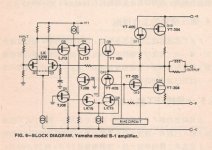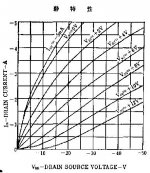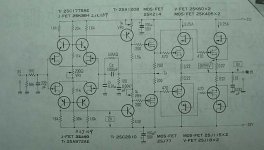Intresting indeed, no substrate diode to mess with in SMPS applications. Looks promising, but at the moment only single manufacturerdimitri said:
The Yamaha B1 was 150W per channel, two outputs per channel, quasi-comp.
The Yamaha B2 was 100W per channel, four outputs per channel, full-comp.
Spares? Can you say un-obtanium?
Supertex makes an inexpensive (under $1 in one lot qty) depletion mode N-ch in a TO220 case rated at 500mA and 15W. Mouser sells them.
The Yamaha B2 was 100W per channel, four outputs per channel, full-comp.
Spares? Can you say un-obtanium?
Supertex makes an inexpensive (under $1 in one lot qty) depletion mode N-ch in a TO220 case rated at 500mA and 15W. Mouser sells them.
Can we dig some of these up and make a mini-a type amp to see how they sound? 24V 50A would be enough, right?
All HV JFET come with reduced Gm and increased capacitances.
2N6449/6450 also have TO-39 case, with gate connected to the case.
Same feature is in all Siliconix TO-5/39 cases. These cases will require heatsinks in Power Amp. applications for any reasonable/meaningful bias.
Try to locate 2SK73 from Panasonic/Matsushita (and let me know ) - 200 V, 5W, <100 mA, JFET in TO-126 case. But don't get excited when you find them - you will actually get 3SK73 4pin DIP RF transistor from Toshiba
) - 200 V, 5W, <100 mA, JFET in TO-126 case. But don't get excited when you find them - you will actually get 3SK73 4pin DIP RF transistor from Toshiba
I consider MOSFETs to be a much better choice for PA applications, because noise is not a problem at those input voltage levels.
If one needs depletion power types, look at:
DN2535/2540 - TO-220, Supertex
IXTP02N50D - TO-220, IXYS, don't overlook another part from them -IXCP10M35(or 45)S
BST124 - TO-126, Philips
IXYS has online store "Directed Energy". My experience with them is great - they will do whatever it takes to make their customers happy. Ask them what you need.
Actually, Depl. MOSFETs also have increased capacitances, so Ench. MOSFETs are the best choice for best Gm/C ratio (or, going back to the future, small signal complimentary JFETs ). As always, it is a matter of personal preferences and the task on hand.
). As always, it is a matter of personal preferences and the task on hand.
It is also looks like the memory of HV/Power JFETs of the '70's is not going away . Those were Vertical JFETs with output characteristics of "triode" type (very low output impedance), as opposite to all other JFETs and MOSFETs with "pentode" type characteristics (high output impedance).
. Those were Vertical JFETs with output characteristics of "triode" type (very low output impedance), as opposite to all other JFETs and MOSFETs with "pentode" type characteristics (high output impedance).
Those compl. pairs are:
2SJ18 - 2SK60, ~63 W, 170 V, Sony,
J19 - K69, 800 mW (at 150°C), 140 V, TO-5, NEC
J20 - K70, ~100 W, 100 V, NEC
J21 - K71, 15 W, 160 V, TO-66, NEC
??? - K75, TO-66, Yamaha
J26 - K76, ~100 W, 200 V, Yamaha
J27 - K77, ~100 W, Yamaha
J28 - K82, ~100 W, 240 V, Sony
J29 - K89, ~100 W, 110 V, Hitachi
J38 - K98, from Yamaha, used in their organs, so organ repair services may have it. (I hope, they are complimentary).
IF there were any other COMPL. pairs, logically they would be among J30/31 and K90/91. In those days, if it was in TO-3 case, it was power Vertical JFET (Power MOSFETs arrived later).
Needless to say, they all are discontinued long ago, and it will take an extensive search to find them. One place to look for that type of parts is Asian B2B marketplace: http://www.hkinventory.com/public/OfferInventResult.asp
2N6449/6450 also have TO-39 case, with gate connected to the case.
Same feature is in all Siliconix TO-5/39 cases. These cases will require heatsinks in Power Amp. applications for any reasonable/meaningful bias.
Try to locate 2SK73 from Panasonic/Matsushita (and let me know
I consider MOSFETs to be a much better choice for PA applications, because noise is not a problem at those input voltage levels.
If one needs depletion power types, look at:
DN2535/2540 - TO-220, Supertex
IXTP02N50D - TO-220, IXYS, don't overlook another part from them -IXCP10M35(or 45)S
BST124 - TO-126, Philips
IXYS has online store "Directed Energy". My experience with them is great - they will do whatever it takes to make their customers happy. Ask them what you need.
Actually, Depl. MOSFETs also have increased capacitances, so Ench. MOSFETs are the best choice for best Gm/C ratio (or, going back to the future, small signal complimentary JFETs
It is also looks like the memory of HV/Power JFETs of the '70's is not going away
Those compl. pairs are:
2SJ18 - 2SK60, ~63 W, 170 V, Sony,
J19 - K69, 800 mW (at 150°C), 140 V, TO-5, NEC
J20 - K70, ~100 W, 100 V, NEC
J21 - K71, 15 W, 160 V, TO-66, NEC
??? - K75, TO-66, Yamaha
J26 - K76, ~100 W, 200 V, Yamaha
J27 - K77, ~100 W, Yamaha
J28 - K82, ~100 W, 240 V, Sony
J29 - K89, ~100 W, 110 V, Hitachi
J38 - K98, from Yamaha, used in their organs, so organ repair services may have it. (I hope, they are complimentary).
IF there were any other COMPL. pairs, logically they would be among J30/31 and K90/91. In those days, if it was in TO-3 case, it was power Vertical JFET (Power MOSFETs arrived later).
Needless to say, they all are discontinued long ago, and it will take an extensive search to find them. One place to look for that type of parts is Asian B2B marketplace: http://www.hkinventory.com/public/OfferInventResult.asp
Attachments
Thanks Steven for the valuable information......
Grey cascode is nicer option but if amp is running at +- 150V rails , then it needs high voltage at least 150V JFETs...
Anyone having information regarding P-channel JFETs upto 120V manufactured presently...
regards,
K a n w a r
Grey cascode is nicer option but if amp is running at +- 150V rails , then it needs high voltage at least 150V JFETs...
Anyone having information regarding P-channel JFETs upto 120V manufactured presently...
regards,
K a n w a r
StevenOH said:It is also looks like the memory of HV/Power JFETs of the '70's is not going away. Those were Vertical JFETs with output characteristics of "triode" type (very low output impedance), as opposite to all other JFETs and MOSFETs with "pentode" type characteristics (high output impedance).
Those compl. pairs are:
2SJ18 - 2SK60, ~63 W, 170 V, Sony,
J19 - K69, 800 mW (at 150°C), 140 V, TO-5, NEC
J20 - K70, ~100 W, 100 V, NEC
J21 - K71, 15 W, 160 V, TO-66, NEC
??? - K75, TO-66, Yamaha
J26 - K76, ~100 W, 200 V, Yamaha
J27 - K77, ~100 W, Yamaha
J28 - K82, ~100 W, 240 V, Sony
J29 - K89, ~100 W, 110 V, Hitachi
J38 - K98, from Yamaha, used in their organs, so organ repair services may have it. (I hope, they are complimentary).
...
Thanks for the RARE picture of the Hitachi VFET, in fact I am not sure anyone has seen it in real life!
The memory will not go away and it would truly be a blessing for many audio designers if a company decided to produce them again. When they were originally made, the anizotropic etching process was new and expensive, today it would be an easy thing to do. The characteristics are indeed very triode-like (see attachment).
BTW 2SJ18/2SK60 are 5A 160V types, 2SJ28/2SK82 are 10A 200V types. The first were used in class AB amps, the second in Sony's class D offering which is still bleeding edge even today (500kHz fixed frequency design from 1978!).
The problem with these parts, apart form the price, was the very fact they were depletion mode, with Vp of about 25V for the J18/K60, and a whopping 55V on the J28/K82. Unlike small signal FETs which can self-bias due to small Vp and small currents and not waste huge amounts of power, the VFET needs an auxiliary power supply, which MUST be present before the application of the main power supply, otherwise in a class AB complementary amp, your output is shorting the main power supply.
By teh end of the Sony VFET amp line, they used a hybrid power stage, composed of a BJT/VFET cascode, which circumvents the need for extra power supplies.
2SJ18/2SK60 can still be found on occasion, whereas the other VFETs are practically unobtainium: about the only way to get them is to buy broken VFET amps on Ebay, but since these have a following, prices are up. For instance, a working pair of 2SJ28/2SK82 (normally impossible to find) can easily go into the 100$ price region.
Just for fun, here are the Id / Vd @ Vg curves for the 2SJ18:
Attachments
Good HV/Power regular N-ch. JFET were manufactured by Teledyne, like
SU2037: 100 V, 10 W, S>20 mS, Vp<15 V, TO-59 (bolt type case),
U1715A: 125 V, 50(?) mA, bolt type case.
More "modern" Vertical JFETs, called SIT, are 2SK180, 181, among others from Tokin: 600/800 V, 20 A, 300 W, Vp~30 V, mu~10 at 0.1 A, Cin~2,500 pF, Ron<1.5/2 Ohm at 2 A, TO-3 case. All V-JFET have mu~4 (and at ~1 A current), but also with smaller capacitance.
Another SIT from them worth mentioning is 2SK1383: TO-39 case, 200 V, 3 A, 8 W, S>12 S, Ron<0.3 Ohm at 1 A.
A lot of info about SIT/V-JFET can be found at Shinichi Kamijo site:
http://www.ne.jp/asahi/evo/amp/contents.htm
(It is interesting to compare the characteristics of V-JFET and SIT - SIT is more triode-like and uniform.)
http://www.ne.jp/asahi/evo/amp/SITamp.htm - this page starts with readers' complain about the difficulty of finding the 2SK180 (in Japan!). Again, the B2B sites will tell you, if it still available...
As it was mentioned before (on this forum and elsewhere), there are several companies working currently on the development of Silicon Carbide SIT. Yes, the interest is there. But, it will take time...
Does anyone have info/specs for TO-5 transistors on this pic?:
http://www.thevintageknob.org/VFET/B1display/B1display.html
B-1 amp. uses 2SJ24, LJ13, LK13. Maybe someone has the schematic with nodes voltages and semiconductor parts list to share?
And, as a bonus , pic of 2SJ29 from Hitachi...
, pic of 2SJ29 from Hitachi...
SU2037: 100 V, 10 W, S>20 mS, Vp<15 V, TO-59 (bolt type case),
U1715A: 125 V, 50(?) mA, bolt type case.
More "modern" Vertical JFETs, called SIT, are 2SK180, 181, among others from Tokin: 600/800 V, 20 A, 300 W, Vp~30 V, mu~10 at 0.1 A, Cin~2,500 pF, Ron<1.5/2 Ohm at 2 A, TO-3 case. All V-JFET have mu~4 (and at ~1 A current), but also with smaller capacitance.
Another SIT from them worth mentioning is 2SK1383: TO-39 case, 200 V, 3 A, 8 W, S>12 S, Ron<0.3 Ohm at 1 A.
A lot of info about SIT/V-JFET can be found at Shinichi Kamijo site:
http://www.ne.jp/asahi/evo/amp/contents.htm
(It is interesting to compare the characteristics of V-JFET and SIT - SIT is more triode-like and uniform.)
http://www.ne.jp/asahi/evo/amp/SITamp.htm - this page starts with readers' complain about the difficulty of finding the 2SK180 (in Japan!). Again, the B2B sites will tell you, if it still available...
As it was mentioned before (on this forum and elsewhere), there are several companies working currently on the development of Silicon Carbide SIT. Yes, the interest is there. But, it will take time...
Does anyone have info/specs for TO-5 transistors on this pic?:
http://www.thevintageknob.org/VFET/B1display/B1display.html
B-1 amp. uses 2SJ24, LJ13, LK13. Maybe someone has the schematic with nodes voltages and semiconductor parts list to share?
And, as a bonus
Attachments
Kanwar how about Russian SITs? They seem to produce 150V both N- and P-types and probably higher voltage only N-type.
Try to ask for them at distribution company: www.platan.ru
Try to ask for them at distribution company: www.platan.ru
housing said:Is there any class AB amplifier circuit for the pair of 2SJ28/2SK82 ?
With a pinch-off voltage of ~40V, i doubt it. besides, if you actually have these transistors, then anyone owning a Sony TA-N88(B) will be interested in buying them from you - and so use them for what they were made in the first place.
2SK373 100 Volt N-JFET
2SK373 100 Volt N-JFET
at www.ampslab.com
I have also added simulation spice models for these
in my MultiSim
2SK373-GR Toshiba TO-92. Price: US$20.00 for 20 pieces
Which makes it US$1 per each.
more info and details, datasheet
http://www.ampslab.com/components.htm
100 Volt N-JFET devices can be very useful
not at least in
- Power Amplifiers inputs
- Higher voltage CCS, Constant current sources using JFET
Regards
lineup
Lineup Audio JFET Amplifiers Inc.
2SK373 100 Volt N-JFET
at www.ampslab.com
I have also added simulation spice models for these
in my MultiSim
2SK373-GR Toshiba TO-92. Price: US$20.00 for 20 pieces
Which makes it US$1 per each.
more info and details, datasheet
http://www.ampslab.com/components.htm
100 Volt N-JFET devices can be very useful
not at least in
- Power Amplifiers inputs
- Higher voltage CCS, Constant current sources using JFET
Regards
lineup
Lineup Audio JFET Amplifiers Inc.
lineup said:2SK373-GR Toshiba TO-92. Price: US$20.00 for 20 pieces[/i]
Which makes it US$1 per each.
It's much cheaper than a CRD.
housing said:
It's much cheaper than a CRD.

CRD - I guess this is short for: Constant Current Diode.
There are such diodes that can take 100 Volt, I know.
They have a fixed current values within some tolerance. +/-%
But as you say, using hivolt JFET may be cheaper.
And of course, using a JFET will allow you to adjust constant current level.
Just by changing resistor (or trimpot) you can set a precise current.
A sidenote
So called Constant Current diode, with only 2 pins
is in fact a JFET with a resistor on the chip! ...
lineup
mtlin12 said:
I followed your link, mtlin12
CRD is a diode which supplies constant current to an electric circuit,
even when power supply voltage fluctuations or load impedance fluctuations occur.
CRD is used for current stabilization and current limiting.
So,
we might as well use my expression for it:
Constant Current Diode
.. as this is a descriptive of the actually function
.. so that all, even non-english + non-engineers + non-audiogurus,
may understand what we say and what we are talking about.
As I told before, these type of diodes
are often made up by JFETs,
but without that the S, source of jfet, is taken to one output pin.
Those two pins of many of these diodes are:
Gate & Drain pins of this in capsule JFET semiconductor.
lineup
- Home
- Amplifiers
- Solid State
- Hi-Voltage JFET's





